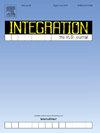交叉参考数字微流控生物芯片的高级故障检测与定位
IF 2.5
3区 工程技术
Q3 COMPUTER SCIENCE, HARDWARE & ARCHITECTURE
引用次数: 0
摘要
交叉参考数字微流体生物芯片(dmfb)正变得越来越有吸引力,因为它显着减少了设计的引脚数。然而,在此架构中同时路由多个液滴是一项具有挑战性的任务。因此,在这种设置中检测多个故障电极得到了更多的关注。本文介绍了一种先进而严格的离线测试技术,解决了电极干扰和动态流体约束的挑战。考虑到在整个测试过程中需要同时管理多个液滴,我们的方法一丝不苟地考虑到每一个细节。除了实际的传播时间外,我们还考虑了从源到达伪源所花费的时间,以及从伪汇到汇所花费的时间。在各种2D网格尺寸上进行了测试模拟,结果表明,与现有方法相比,总检测时间有显著改善。这种提出的技术成功地克服了以前的工作遇到的几个限制。本文章由计算机程序翻译,如有差异,请以英文原文为准。
Advanced fault detection and localization in cross-referencing digital micro-fluidic biochips
Cross-referencing digital microfluidic biochips (DMFBs) is becoming increasingly appealing as it significantly reduces the design's pin count. However, routing multiple droplets simultaneously within this architecture presents a challenging task. As a result, detecting multiple faulty electrodes within this setup has gained more attention. This paper introduces an advanced and rigorous offline testing technique that addresses the challenges of electrode interference and dynamic fluidic constraints. Given the need to manage multiple droplets simultaneously throughout the testing process, our approach meticulously considers every fine detail. We account for the time taken to reach pseudo-sources from the source, and from the pseudo-sinks to the sink, in addition to the actual travel time. Testing simulations have been conducted on various 2D grid sizes, with results showing a significant improvement in total detection time compared to some existing methods. This proposed technique successfully overcomes several limitations that previous works encountered.
求助全文
通过发布文献求助,成功后即可免费获取论文全文。
去求助
来源期刊

Integration-The Vlsi Journal
工程技术-工程:电子与电气
CiteScore
3.80
自引率
5.30%
发文量
107
审稿时长
6 months
期刊介绍:
Integration''s aim is to cover every aspect of the VLSI area, with an emphasis on cross-fertilization between various fields of science, and the design, verification, test and applications of integrated circuits and systems, as well as closely related topics in process and device technologies. Individual issues will feature peer-reviewed tutorials and articles as well as reviews of recent publications. The intended coverage of the journal can be assessed by examining the following (non-exclusive) list of topics:
Specification methods and languages; Analog/Digital Integrated Circuits and Systems; VLSI architectures; Algorithms, methods and tools for modeling, simulation, synthesis and verification of integrated circuits and systems of any complexity; Embedded systems; High-level synthesis for VLSI systems; Logic synthesis and finite automata; Testing, design-for-test and test generation algorithms; Physical design; Formal verification; Algorithms implemented in VLSI systems; Systems engineering; Heterogeneous systems.
 求助内容:
求助内容: 应助结果提醒方式:
应助结果提醒方式:


